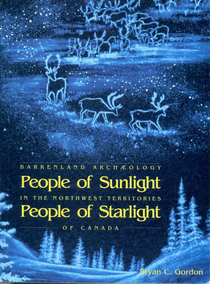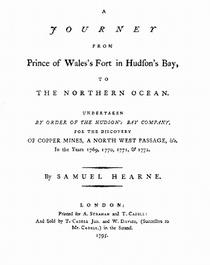 Gordon, Bryan C.
Gordon, Bryan C.
1996 People of Sunlight; People of Starlight: Barrenland Archaeology in the Northwest Territories of Canada. Archaeological Survey of Canada, Mercury Series Paper 154. Canadian Museum of Civilization
This study of the effect of herd following on culture reflects over twenty years of field and laboratory research. The author analyzes and compares some 13,000 artifacts from 1,002 hunting camps of the Northern Plano, Shield Archaic, Pre-Dorset and Taltheilei traditions. Exploring reasons for seasonal tool variation and similarity, he considers geological, biological and historical influences on caribou hunters.
Gordon, Bryan C.
1975 Of Men & Herds in Barrenland Prehistory. Archaeological Survey of Canada, Mercury Series Paper 28. National Museums of Canada.
This study attempts to elucidate the temporal and spatial interrelationships between the barrenland Pre-Dorset peoples, climates and caribou herds in the period 1500-700 B.C. Items such as discreteness of herds and human bands, band movements and communication and differing cultural patterns as evidenced in artifacts, are discussed. All are used in the formulation of the discrete band / discrete herd relationship.
1978 Migod – 8000 Years of Barrenland Prehistory. Archaeological Survey of Canada, Mercury Series Paper 56. National Museums of Canada.
The discrete band / discrete herd association is used to explore 8,000 years of barrenland prehistory at the Migod site, west-central Keewatin District, Northwest Territories The association appears applicable in the four traditions represented ─ Agate Basin, Shield Archaic, Pre-Dorset and Taltheilei.
1979. Of Men and Herds in Canadian Plains Prehistory. Archaeological Survey of Canada, Mercury Series Paper 84. National Museums of Canada.
This is a preliminary study of temporal and spatial relationships between Canadian Plains peoples, climates and bison populations over the past 10,000 years. Discreteness of two bison populations, hunting and band movements and communication are discussed together with the probable role of grassland faciation as a control on bison migration.
2005 8000 Years of Caribou and Human Seasonal Migration in the Canadian Barrenlands. Proceedings of the Tenth North American Caribou Workshop, 4-6 May, 2004. Rangifer, Special Issue No. 16, 2005.
2006 Deciphering archaeological palimpsests – an example from a Canadian Barrenland Rangifer hunting camp. Proceedings of the Meso2005 Archaeological Conference, Queen’s University, Belfast, Ireland. Oxbow Press (in press).
 Hearne, Samuel
Hearne, Samuel
1958 A Journey from Prince of Wales’s Fort in Hudson’s Bay to the Northern Ocean 1769, 1770, 1771, 1772 (ed. by R. Glover). Reprinted Toronto: Macmillan 1958.
The first avocational Barrenland ethnologist, Samuel Hearne was a keen observer of the Chipewyan lifeways, adopting a functional approach to everyday tasks that we examine in our Website.
Burch, Ernest S., Jr.
1972 The caribou/wild reindeer as a human resource. American Antiquity 37:339-68.
1991 Herd following reconsidered. Current Anthropology 32:4:439-444.
Cook, Frederick
1894a Dr. Cook among the Esquimaux: Editorial New York Journal of Gynecology and Obstetrics IV:287.
1894b Gynecology and obstetrics among the Ekimos. Brooklyn Medical Journal 8:154.
1897 Some physical effects of arctic cold, darkness and light. Medical Record 51:833-836.
Parker, Gerry R.
1972 Biology of the Kaminuriak population of barren-ground caribou, Part 1. Canadian Wildlife Service Report Series 20, Ottawa. 95 pp.
1972 Distribution of Barren-Ground caribou harvest in north-central Canada from ear-tag returns. Canadian Wildlife Service, Occasional paper 15, Ottawa. 20 pp.
Smith, J.G.E.
1978 Economic uncertainty in an “Original Affluent Society”: Caribou and Caribou-Eater Chipewyan adaptive strategies.Arctic Anthropology 15:68-88.
1982 Tooth sectioning as an archaeological tool (ed. by Faye Kert), Canadian Studies Report 14e, Archaeological Survey of Canada, National Museum of Man, Ottawa, 4 pp.
Le sectionnement des dents: moyen de recherche archéologique(Révision: Gilles Dansereau), Rapport no 14f sur les Etudes Canadiennes, Comm. archeéologique du Canada, Museée national de l’Homme, Ottawa, 4 pp.
1984 Selected bibliography of dental annular studies on various mammals. Zooarchaeological Research News, Supplement 2, August, pp. 1-24.
1992 Archaeological Seasonality using Incremental Structures in Teeth: An Annotated Bibliography. Zooarchaeological Research News, Special Publication. Spirally bound laboratory reference.
1993 Archaeological tooth and bone seasonal increments: the need for standardized terms and techniques. Archaeolozoologica Vol. V/2,pp.9-16(La Pensée Sauvage: Incremental growth structures in zooarchaeological seasonality).
For more information on publications by the Canadian Museum of History:
| Mailing Address: 100 Laurier Street P.O. Box 3100, Station B Gatineau, Quebec J8X 4H2 Fax orders: |
Phone orders: 1 800 555-5621 (North America only) (819) 776-8387 (National Capital Region) E-mail: boutique@historymuseum.ca |
Links:
Archaeological Survey of Canada
Tooth Sectioning as an Archaeological Tool
Human Role in Reindeer/Caribou Systems
The Borden System of Site Identification
Prince of Wales Northern Heritage Centre
Dene Nation Online Photo Collection
A Glossary of Manitoba Prehistoric Archaeology
Tyrrell Surveys of the Barren Lands – U of T Libraries
More References and Links to come . . .